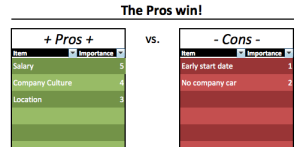Today I’m writing about the best resume format.
With fall job fairs coming up, I want to do more career-related posts. But I’ve already written a good amount of resume and interview content, and it’s pointless to repeat myself.
So I thought, “What haven’t I written about?” That led me to write about resume formatting.
Resume formatting is an underrated topic in the job hunt. How you organize your resume has more power to hurt you than it does to help you.
However, building your resume the right way allows your experiences to shine for employers. That’s why it’s unwise to leave your formatting up to chance.
Go through this guide, instead, to understand the best resume format for your job search. Then you won’t have to sweat getting rejected before your resume and you get a chance.
Why Resume Format Matters
What I found is that most candidates give all their attention to what will go on their resume. Doing so, they fail to realize that how it’s formatted can support or weaken the content.
Although I agree that content is more important, it’s a big mistake to disregard how it’ll be formatted.
For example, crazy disorganization can cause the resume reader to throw the document away before they take a second to view your skills. Or if the reviewer does give your resume the time of day, bad formatting can cause them to miss your key work experiences that make you highly qualified for the job.
Because the employer failed to see your best experience, you’re not asked back for an interview. And that’s a shame, since a minor tweak in your formatting would make all of the difference.
Then consider a second applicant who formats their resume beautifully. This document makes it super clear why they’re qualified and what they can add to the organization. Formatting and organization isn’t on the recruiter’s mind because they’re salivating at this candidate’s skills and qualifications.
The entire job process changes in your favor when you have a great resume. So don’t sleep entirely on your resume format because it does matter.
Keep the importance of formatting in mind, because you’ll be more likely to take action when you know why.
Now that I’ve covered why resume formatting matters, let’s move on to the different types of resumes.
Different Resume Formats
Depending on your experience and the job you’re shooting for, you’ll want to use the resume format that markets yourself the best.
Below are the three different resume format types: chronological, functional, and combination. Be sure to check out the “Why use it?” sections below to know what’s the right one for you.
1) Chronological
As it’s titled, the chronological resume format lists your work experience in a chronological order from your most recent work down to the oldest job. So if you had summer jobs for the past three years, the 2016 work experience would lead, followed by 2015, and end with your 2014 work. The chronological resume format used to always be the most common approach.
Why use it?
What’s nice about it is it’s easy for the resume reviewer to put a timeline together of your work experience. These recruiters and managers are so busy that a chronological order helps them get a summary of you without searching too hard to find what they want.
If you’ve had internships or jobs in the same field all of your life, then the chronological order makes the most sense. Because there’s likely a natural progression of promotions or higher responsibility work in this format.
This order already presents your accomplishments in a positive structure without having to get creative or target certain work experiences over others. For college students looking for their first job, this is a good option (but not the best, in my option).
2) Functional
Functional resumes prioritize your marketable skills, unlike the chronological resumes that focus on dates. Because this type of resume is all about you and how you would add value to the organization, when you worked on something holds less weight. So skills would come before work experience on this resume.
Why use it?
If you’re a young adult with less work experience than you desire, this format is a good option for you. It allows you to highlight your skills while giving less attention to your past work experience.
This is also the better option if you took a gap year from working, to travel the world or for some other reason. In this case, you will want to avoid the chronological format because it would raise unhelpful questions.
Lastly, it makes more sense to do a functional resume when you’re transitioning to a new career. If you do a chronological resume, all your past experiences will point toward your old career and won’t reflect your skills in the new industry.
3) Combination
The combination, or hybrid, resume format is a mix of both the functional and chronological resume. It lists the relevant skills in your arsenal most relevant to the job description, while also having your work history in a chronological order.
When you’re torn between both, you can get the advantages of the chronological and functional resume with this option.
Why use it?
Use the combination format when you have more specific abilities related to the job than work experiences. To market yourself as a college student, I believe this is most often the best option.
And this format can also be used for someone transitioning to a new career, similar to the functional resume.
Once you know the best resume format for your specific situation and goals, it’s time to organize your resume.
Organizing Your Resume
You know the format. Next up is getting your organization down.
An organized resume points toward your competence and preparation, two valuable qualities. A disorganized resume leads the employer to doubt you’re the right person for them.
See the difference? Get organization right, just like formatting, and you’ll put yourself in much better shape in your job search.
How do you organize your resume? I’m going to highlight how a college student should organize their resume.
Personal information
The resume reader needs to first off know your personal information. Important details to include at the top of your resume include: full name, phone number, and email.
If you have a personal website that you’re proud of, include that as well.
Whether to add or leave off your address is a complicated discussion. I’d leave it off my resume, because the argument goes they can use it against you if you’re applying for an out of state job.
Education
As a college student, you want to include your university, its location, your expected graduation date, your major, your GPA if it’s over 3.0, and if you did any special projects with your university (e.g. a senior thesis).
Work experience
Next up is your work history. For each job, include on your resume your job title, the employer, date worked, and then bullet points with your job responsibilities and achievements.
Usually this is done in chronological order from present to latest. However, depending on the resume format you chose, you may list the work experience in order of relevance and disregard dates.
Extracurriculars
Are you a part of a service organization or fraternity? Do you have leadership experience on campus? This is where you’d add the activities you were involved with on campus. Make sure each element is viewed as a positive and not a negative.
Activities and skills
This final section is where you promote the other activities you’ve been involved in or the other skills you have. These can be anything from hard technical skills to soft communication skills.
If you’ve been a professional for a few years out of college, then your resume will look different. The organization would be better off with work experience leading the way:
- Personal information
- Work experience
- Other experience
- Education
- Activities
As you noticed, I didn’t include an objective statement as a section because I feel they’re outdated. Plus, the employer only cares about their objective, not yours.
Final Words
Formatting isn’t going to win you any job offers. Bad formatting, however, can lose the resume reader’s patience and cost you the job.
So the goal of formatting is to present your experiences and accomplishments in the best light possible. It’s not to play hero. It’s to play a nice sidekick role.
After reading this long guide, I hope you now understand the importance of this organization and how to format your resume.
Once you do this, order my Amazon bestselling book The Golden Resume. This guide lays out the exact tactics I used to land countless job offers.
The job search is like a game. After you know how to win, you can repeat the steps until you get your dream job offer. You can do it!



